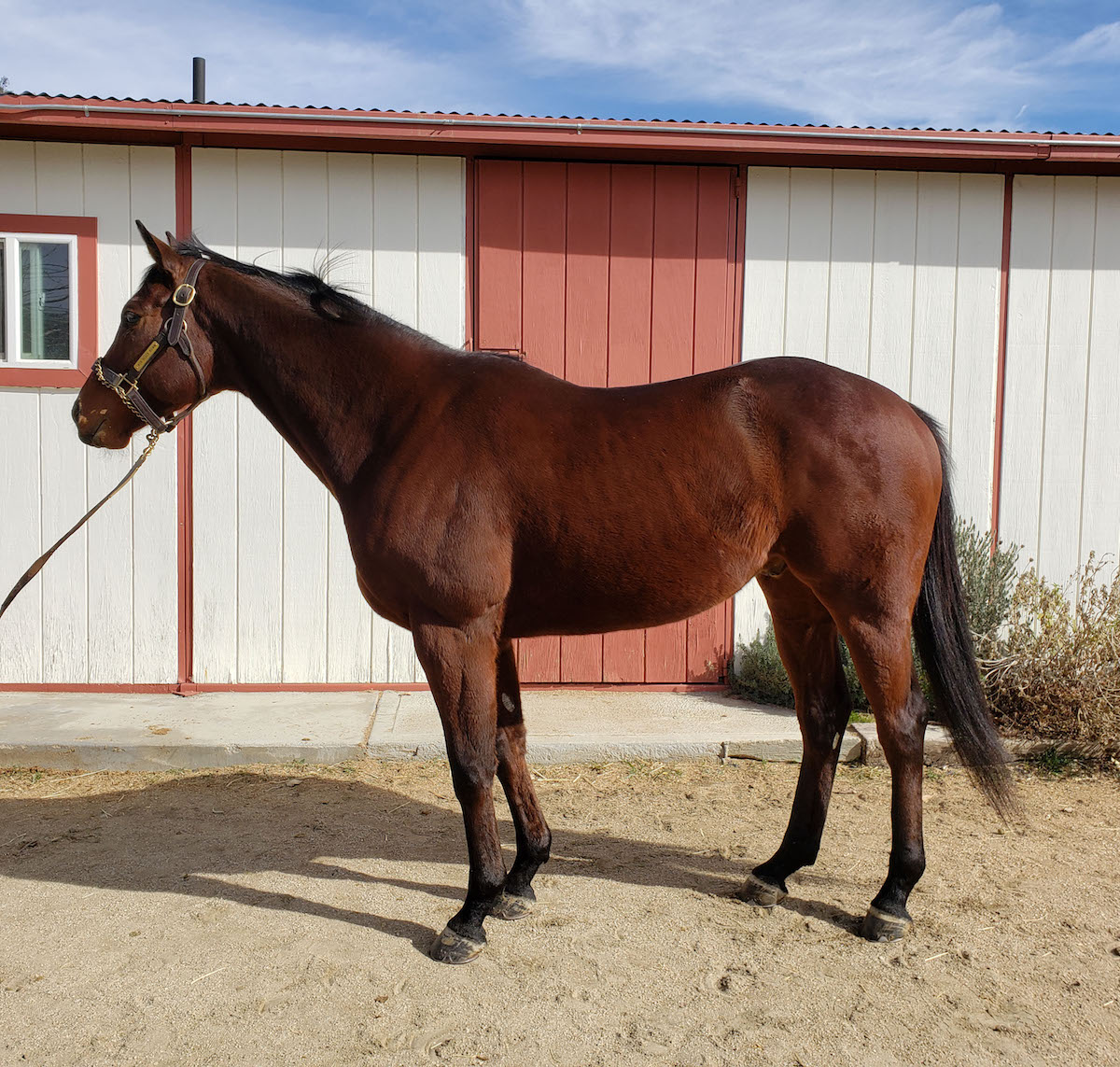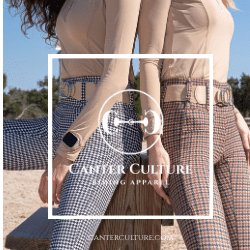Makeover trainers evaluate sport horse potential based on conformation shots
Social media has enabled potential OTTB owners to review a large number of retiring Thoroughbred racehorse listings at any given time. Newcomers to the breed might find it challenging to consider a prospect right off the track and decide if it’s a match for their desired purpose.
In this column veteran Thoroughbred Makeover trainers — professionals, juniors and amateurs alike — share their thoughts about assessing and selecting prospects and evaluate example horses based only on their conformation photos. We feature trainers from two disciplines in each issue.
Our Trainers
■ Katelin Bradley
Amateur, fifth place in Barrel Racing at the 2018 Thoroughbred Makeover with Metro Maggie
Hailing from Northern Wisconsin, Bradley is a lifelong barrel racer, rodeo supporter (she was the Professional Rodeo Cowboys Association’s Miss Rodeo Wisconsin in 2017) and Thoroughbred enthusiast, having ridden retired racehorses for most of her career in barrel racing, pole bending and Miss Rodeo Wisconsin mounted duties. Her love for the Thoroughbred as a Western mount inspired her to create The Western Thoroughbred, a grassroots effort to spotlight the breed in various disciplines through social media, a website, and a growing presence at competitions. She is currently working 2018 Thoroughbred Makeover graduate The Love Monkey, with plans to compete this year.
■ Alison O’Dwyer
Professional, winner of Dressage at the 2019 Thoroughbred Makeover with Fifth Ace
O’Dwyer has found her niche in identifying and developing young Thoroughbreds for second careers, with a strong background in eventing and dressage. She has evented through the CCI*** level and earned her United States Dressage Federation bronze medal. A native of Colorado, O’Dwyer spent the past 11 years in Lexington, Kentucky, but recently relocated to Maryland. Her win in Dressage at the 2019 Thoroughbred Makeover was just the latest in a series of top 10 finishes: In 2018 she was second in Eventing with Big Ralph and in 2017 second in Eventing and first in Dressage with Chapter Two.
Choosing a Horse
Katelin Bradley and Alison O’Dwyer emphasize evaluating conformation when analyzing a prospect and, despite their different disciplines, noted that they like to see a balanced, well-set neck, a long, sloping shoulder and solid feet. Bradley prefers shorter cannon bones and low hocks for her barrel racers, with a long underline and generally athletic appearance. O’Dwyer looks for an uphill build with a short back that indicates a horse will likely have the movement and gaits she desires.
Due to barrel racing’s physical demands, Bradley searches for horses that come with no limitations or history of major injury. O’Dwyer looks at a horse’s racing record to keep an eye on long gaps that might suggest time off to rehabilitate an injury. She also notes what kind of surfaces a horse might have run on: “Dirt sprinters, two-turn grass horses and polytrack champions are all likely to have different body types, different ways of going and different training that is important to take notice of.”
For O’Dwyer, bloodlines are less important than conformation, history and personality. Bradley does have a few favorite bloodlines she looks for based on past performances of Thoroughbreds and of barrel horses with Thoroughbreds in their pedigrees. “Sprinters tend to have barrel horse conformation more frequently than those bred to run classic distances,” she notes. “Ultimately, though, good breeding is good breeding.”
O’Dwyer generally acquires her horses directly from trainers at the track, having built a personal network over the years and being honest and upfront about her abilities as a horsewoman. Bradley has acquired her horses through a variety of channels, including private sellers and rehoming programs, and recommends the latter to first-time OTTB owners, because they specialize in transitioning horses from the track. Bradley also consults experienced barrel racers in her network to help assess prospects’ conformation.
Meet the Prospects
Our model horses all come from Win Place Home, in Canyon Country, California. Win Place Home was founded in 2015 by CJ Marinaccio, who had worked on the racetrack for 10 years as both an assistant trainer and a vet tech. Regularly offered horses to help retire, Marinaccio spent five years planning and preparing to open Win Place Home as a charitable aftercare organization that took in its first horse in February 2016. Since opening, Win Place Home has adopted out 10 horses successfully and has 10 horses in the barn for retraining.
Win Place Home takes in horses it has the means to support for a year and gives them solid foundations before listing them for adoption. The organization also rehabilitates injured horses before retraining. All three of these horses are available for adoption and eligible for the 2020 Thoroughbred Makeover. While they might no longer be available at press time, Win Place Home has plenty of prospects looking for their next partners.

Trappe The Moment (Trappe Shot — Lady Siphonica, Siphon) Courtesy Win Place Home

La Matrona (Soldat — Rein In Avaricity, Include) Courtesy Win Place Home

Mr. Orb (Orb — Deep Feeling, Empire Maker) Courtesy Win Place Home
Bradley’s Picks
Horse 1 The first horse has an attractive head, a muscular shoulder and a decent hip. His pasterns are at a good angle and length, indicating that he could handle a concussive sport such as barrel racing. He also has substantial bone and looks to have good feet.
He is a bit straight through the stifles and hocks, but not to a degree that should limit his performance. He does have a longer neck that dips slightly in front of his withers. This may indicate that he prefers to travel with his head high. Suppling and proper conditioning could overcome that tendency.
Overall, he is the most balanced from front to back. I imagine he would travel slightly uphill and reach underneath himself well. It would be perfect if he had lower-set hocks, but he looks like an athletic individual. This horse could probably excel in several disciplines, and I would not hesitate to try him as a barrel horse.
Horse 2 The second horse has a pretty expression, a nice neck and a lower-set hock. She has a long underline and would likely be an uphill ride. Her shoulder and hip angles appear to match, but they are rather steep. A deeper shoulder and a larger hip would be preferred for barrel racing.
The prominence of her withers and shape of her back might complicate saddle fit, but its limitations could be overcome with proper training and conditioning — she’s a bit undermuscled everywhere. She is fine-boned, and her feet are small; I would be concerned that she may not hold up in intense competition. I would not pick her as a barrel horse prospect but, overall, she is a bit more balanced than the third-ranked horse.
Horse 3 The third horse has a cute face, a deep girth and correct legs. He has decent bone and good feet. However, his neck is a bit short, which might make it difficult for him to balance in a turn. His hocks are straight, high and relatively small. This would likely limit his ability to propel himself forward. He has a sizable hip, but it is heavier than his shoulder, which makes him appear less balanced overall.
He looks as if he would have a long stride. He might be able to make up time between the barrels but would most likely struggle in the turns. His expression makes me think he would be a sweet, trainable fellow who could succeed in disciplines better suited to his build.
O’Dwyer’s Picks
Horse 2 I honestly think there is very little separating these three horses once you tally up the pros and cons. Ideally, I would have more pictures or an in-person experience to help differentiate them more, but that’s not the case today. This horse has my favorite head, a bit more refined than the others with a good eye and expression. I like this horse’s big, sloping shoulder; it’s pretty close to the ideal 45-degree angle. She also looks to have the best angles in her hind end and hind leg, which suggest to me a good jumper and comfortable canter.
This horse’s withers are more pronounced than I would want, but we always have to make compromises somewhere. It is possible over time, with working the horse over the back, that she can develop topline muscles to help in this area. The plus to this horse’s back is that it’s short; I gravitate toward short-coupled horses because it can be easier to adjust their stride when needed. The feet on this horse tend to have less heel and substance, however, so I would be sure to look at that more closely and take it into consideration.
Horse 1 My overall impression is that this horse is compact and sturdy; with development this horse would likely end up being pretty thick. I am small and tend to do better with more refined body types. His head is more square-shaped than Horse 2, but he still has a nice expression and eye. His shoulder is a little shorter than I like and with a little less angle. He does have a well-set neck, which is important for dressage when asking a horse to be truly connected through its topline.
The hip angle on this horse is nice and open, although the hind leg is a bit straight for what I’d want for jumping and the canter. The front pasterns compared to the rest of the leg are a little long for my taste, as well. This is important for long-term soundness within jumping disciplines. The feet look to have a nice heel and appear to be very solid.
Horse 3 This horse looks to have great bone, which is an asset in any discipline. I really like his front end, good shoulder length and angle with, again, a well-set neck. I like the ratio of his front legs, with nice compact cannon bones and especially pasterns. That would all suggest to me long-term soundness.
Unfortunately, I am not sure this horse has a hind end that matches his front end. His hind leg is definitely straighter than what I would want for a comfortable canter and a good jump. His back is a little long, which can be an issue when you’re my size and trying to compress a horse enough on cross-country to come into a combination. Having ridden big, lengthy horses, these are now things I think about when evaluating a prospect’s conformation.
He definitely has a flat croup, but he still has a good, open hip angle. Like Horse 1, this horse looks to have good, solid feet with a visible heel, which can be hard to find in horses coming off the track.
This article was originally published in the Spring 2020 issue of Off-Track Thoroughbred Magazine, the only publication dedicated to the Thoroughbred ex-racehorse in second careers. Want four information-packed issues a year delivered to your door or your favorite digital device? Subscribe now!

